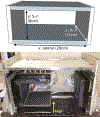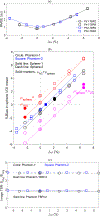Impact of Using Uniform Attenuation Coefficients for Heterogeneously Dense Breasts in a Dedicated Breast PET/X-ray Scanner
- PMID: 33163753
- PMCID: PMC7643852
- DOI: 10.1109/trpms.2020.2991120
Impact of Using Uniform Attenuation Coefficients for Heterogeneously Dense Breasts in a Dedicated Breast PET/X-ray Scanner
Abstract
We investigated PET image quantification when using a uniform attenuation coefficient (μ) for attenuation correction (AC) of anthropomorphic density phantoms derived from high-resolution breast CT scans. A breast PET system was modeled with perfect data corrections except for AC. Using uniform μ for AC resulted in quantitative errors roughly proportional to the difference between μ used in AC (μ AC) and local μ, yielding approximately ± 5% bias, corresponding to the variation of μ for 511 keV photons in breast tissue. Global bias was lowest when uniform μ AC was equal to the phantom mean μ (μ mean). Local bias in 10-mm spheres increased as the sphere μ deviated from μ mean, but remained only 2-3% when the μ sphere was 6.5% higher than μ mean. Bias varied linearly with and was roughly proportional to local μ mismatch. Minimizing local bias, e.g., in a small sphere, required the use of a uniform μ value between the local μ and the μ mean. Thus, biases from using uniform-μ AC are low when local μ sphere is close to μ mean. As the μ sphere increasingly differs from the phantom μ mean, bias increases, and the optimal uniform μ is less predictable, having a value between μ sphere and the phantom μ mean.
Keywords: Attenuation correction; Breast PET; Positron Emission Tomography; Quantitative PET; Simulation.
Figures







Similar articles
-
Impact of non-uniform attenuation correction in a dynamic [18F]-FDOPA brain PET/MRI study.EJNMMI Res. 2019 Aug 19;9(1):77. doi: 10.1186/s13550-019-0547-0. EJNMMI Res. 2019. PMID: 31428975 Free PMC article.
-
Integrated PET/MR breast cancer imaging: Attenuation correction and implementation of a 16-channel RF coil.Med Phys. 2016 Aug;43(8):4808. doi: 10.1118/1.4959546. Med Phys. 2016. PMID: 27487899
-
Dual energy CT for attenuation correction with PET/CT.Med Phys. 2014 Jan;41(1):012501. doi: 10.1118/1.4828838. Med Phys. 2014. PMID: 24387525 Free PMC article.
-
Effects of MR surface coils on PET quantification.Med Phys. 2011 Jun;38(6):2948-56. doi: 10.1118/1.3583697. Med Phys. 2011. PMID: 21815368 Free PMC article.
-
X-ray-based attenuation correction for positron emission tomography/computed tomography scanners.Semin Nucl Med. 2003 Jul;33(3):166-79. doi: 10.1053/snuc.2003.127307. Semin Nucl Med. 2003. PMID: 12931319 Review.
Cited by
-
Advances in Breast PET Instrumentation.PET Clin. 2024 Jan;19(1):37-47. doi: 10.1016/j.cpet.2023.09.001. PET Clin. 2024. PMID: 37949606 Free PMC article. Review.
-
Evaluating attenuation correction strategies in a dedicated, single-gantry breast PET-tomosynthesis scanner.Phys Med Biol. 2020 Dec 23;65(23):235028. doi: 10.1088/1361-6560/abc5a8. Phys Med Biol. 2020. PMID: 33113520 Free PMC article.
References
-
- Qian H, Wangerin KA, Wagadarikar A, Manjeshwar RM, MacDonald LR, Kinahan PE, Image Reconstruction in Rectangular PET Systems Using Distance-Driven Projections, 2013 IEEE Nuclear Science Symposium and Medical Imaging Conference Proceedings, 2014. DOI: 10.1109/NSSMIC.2013.6829338 - DOI
-
- MacDonald L, Hunter W, Zeng G, Pierce L, Dolinski S, DeWitt D, Miyaoka R, Kinahan P, "The PET/X dedicated breast-PET scanner for optimizing cancer therapy", Proc. SPIE 10718, 14th International Workshop on Breast Imaging (IWBI 2018), 107180M (6 July 2018); doi: 10.1117/12.2318419 - DOI
Grants and funding
LinkOut - more resources
Full Text Sources
Research Materials
